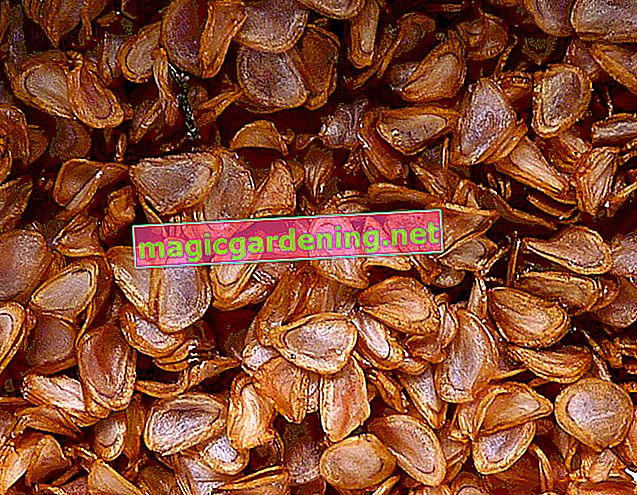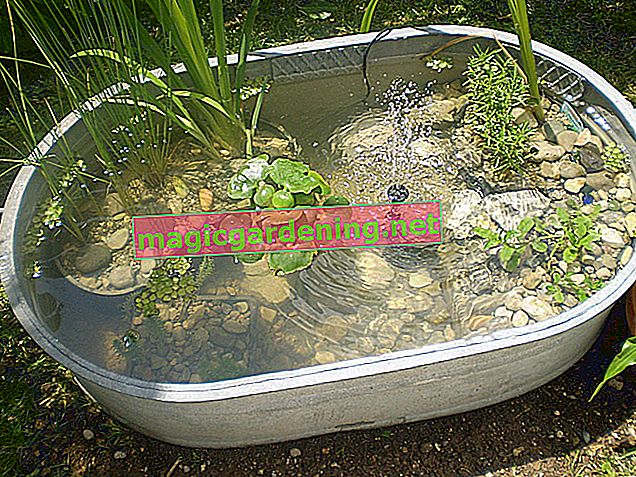
Plant magic bells correctly
The departure of the ice saints in mid-May heralds the beginning of the planting time for magic bells. Put the still potted young plants with the root ball in soft water while you prepare the soil in the sunny location to make fine crumbs. The young Calibrachoa take up small planting pits at a distance of 20-25 cm. It is a good idea to mix some peat or rhododendron soil into the excavation. The addition of deciduous or coniferous compost also contributes to optimal starting conditions. To properly plant the enchanting summer flowers in pots and flower boxes (€ 13.18 at Amazon *), proceed as follows:
- Place a pottery shard over the water drain as a drainage
- Pour in bog soil or rhododendron soil to a third
- Place 5 Calibrachoa per running meter in the loose soil and press on
- Leave a pouring margin of 2-3 cm
also read
- Hibernate the magic bell - is that possible?
- Magic bells and petunias: similarities and differences
- The right care for a richly blooming magic bell
Do not set the plants any deeper than they were previously in the nursery pot. Finally, pour on with soft water.
Care tips
The care program for Calibrachoa is primarily based on a well-balanced water and nutrient balance. The sunnier the location and warmer the temperatures, the greater the need for watering. Therefore, check the substrate in the bed and pail daily with a thumb test. If the top 1-2 cm feel dry, the magic bells are poured with soft water. From May to September the irrigation water contains a liquid fertilizer for petunias every 14 days. This special preparation is formulated in such a way that it provides all the important nutrients plus iron. The third pillar of successful cultivation is the repeated cut. If you shorten the tendrils by a third every couple of weeks, a brilliant abundance of flowers will develop. You can save yourself time-consuming cleaning with magic bells.
Continue reading
Which location is suitable?
So that the floral jewelery in the bed and on the balcony meet expectations, the location should be as follows:
- Sunny location without summer heat build-up
- Permeable, humus soil, fresh and not too dry
- Ideally an acidic pH of 5.5 to 6.0
While with petunias the focus is always on protection from wind and rain, Calibrachoa prove to be significantly more resistant in this regard.
What soil does the plant need?
Magic bells live up to their name when a slightly acidic soil predominates in the sunny location. Otherwise, the attributes of normal garden soil are advantageous, such as nutrient-rich, humus, fresh-moist and well-drained. As a substrate for pots and balcony boxes, we therefore recommend rhododendron soil or bog soil, which have a natural pH value of 5.5 to 6.0.
When is the flowering time?
Calibrachoa present their lavish abundance of flowers in the bed and on the balcony from May to October. Clean withered flowers regularly, always attract new buds and create a well-groomed appearance. If this work is too time-consuming for you, you should wait a short time until the flowers have dried, because they will quickly overgrow.
Cut magic bells correctly
If you cut Calibrachoa back by a third every 2 to 3 weeks, the summer beauties will branch out without ceasing. If the other framework conditions are correct, the plant is covered with a dense flower pile that almost completely covers the green leaves. Since overwintering the extremely cold-sensitive magic bells is not worthwhile, wait for the seeds to ripen in autumn, collect the seeds and dispose of the rest on the compost.
Pour magic bells
Water your magic bells regularly with soft water, because drought stress noticeably affects the abundance of flowers. This can be the case every day on warm summer days. So check the moisture content every morning or evening with a finger so that you can immediately water if necessary. A coaster is poured out after a few minutes to prevent damaging waterlogging.
Fertilize magic bells properly
A balanced supply of nutrients is one of the main pillars of professional care. Calibrachoa require plenty of fertilizer, both in the bed and in the planter. From May to September, give a liquid petunia fertilizer every 14 days, which are tailored to the specific iron requirement. The addition of compost is not advisable due to the sensitive roots and the dense flowers and leaves.
Overwinter
With a view to the uncomplicated sowing, the majority of hobby gardeners decide against an elaborate wintering of Calibrachoa. If you would like to dare to experiment, cut the tendrils back to 10 cm in autumn. Carry the cold-sensitive magic bells in a bright winter quarter. At temperatures between 10 and 12 degrees Celsius, pour soft water from time to time so that the root ball does not dry out. There is no fertilization in this phase. From the middle / end of April you gradually get the plants used to the sunlight and warmer temperatures, repot in fresh substrate so that they are prepared for life in the open air from mid-May.
Continue reading
Propagate magic bells
If the magic bells run out of breath in autumn, exercise a little patience and do not dispose of the busy flowers prematurely. Instead, wait until the green seed pods turn brown and collect them. In the airy, dry place, the capsules open quickly and release the valuable seeds. In January, sow the fine seeds on the partially shaded, warm window sill and breed the next generation by May. Alternatively, cut non-blooming head cuttings in early summer so that they can root in a small pot with poor substrate.
Is magic bell poisonous?
Botanists assign the magic bell to the nightshade family. Thus flower beauty is distantly related to popular crops such as potatoes and tomatoes. You can therefore rest assured that Calibrachoa can be used safely in the family garden.
Yellow leaves
With yellow leaves, the magic bell signals discomfort due to a lack of nutrients. The impairment is triggered by the use of calcareous irrigation water. The lime content accumulates in the substrate, so that vital iron is determined. You should therefore switch to collected rainwater or decalcified tap water. Special iron fertilizers available from specialist dealers provide a short-term remedy.
Nice varieties
- Ruby of the valley: Blooming profusely with ruby red flowers, very healthy and extremely robust; Balcony plant of the year 2012
- Deep Yellow: Impresses with its spherical growth and bright yellow flowers all summer long
- Chameleon Sunshine Berry: A firework of blossoms in pink and yellow on vines up to 60 cm long; ideal for the traffic light
- Petticoat: Double-blooming calibrachoa of the extra class in enchanting colors from light yellow to dark purple
- Lemon Ice: unfolds a sea of flowers with white bells adorned by a light yellow eye








